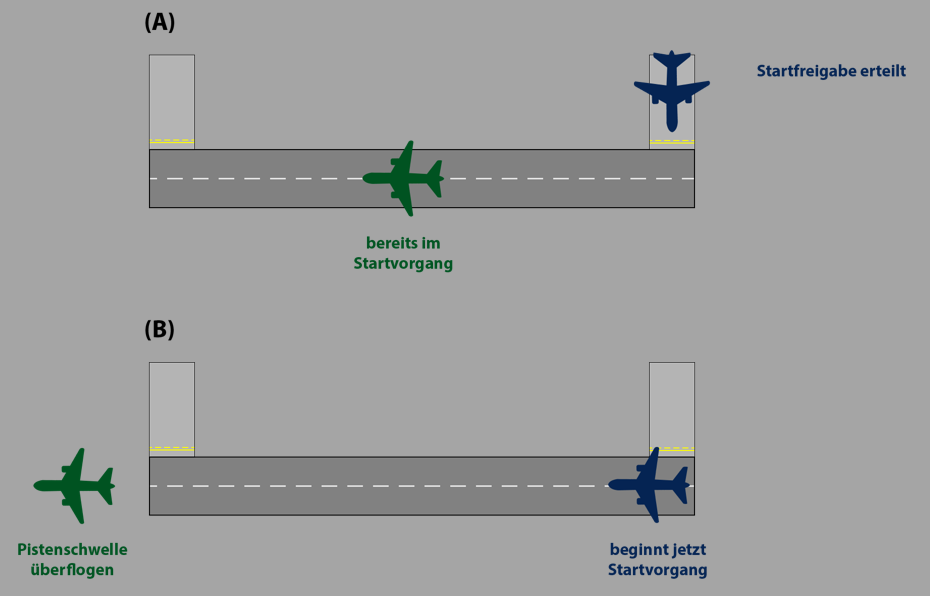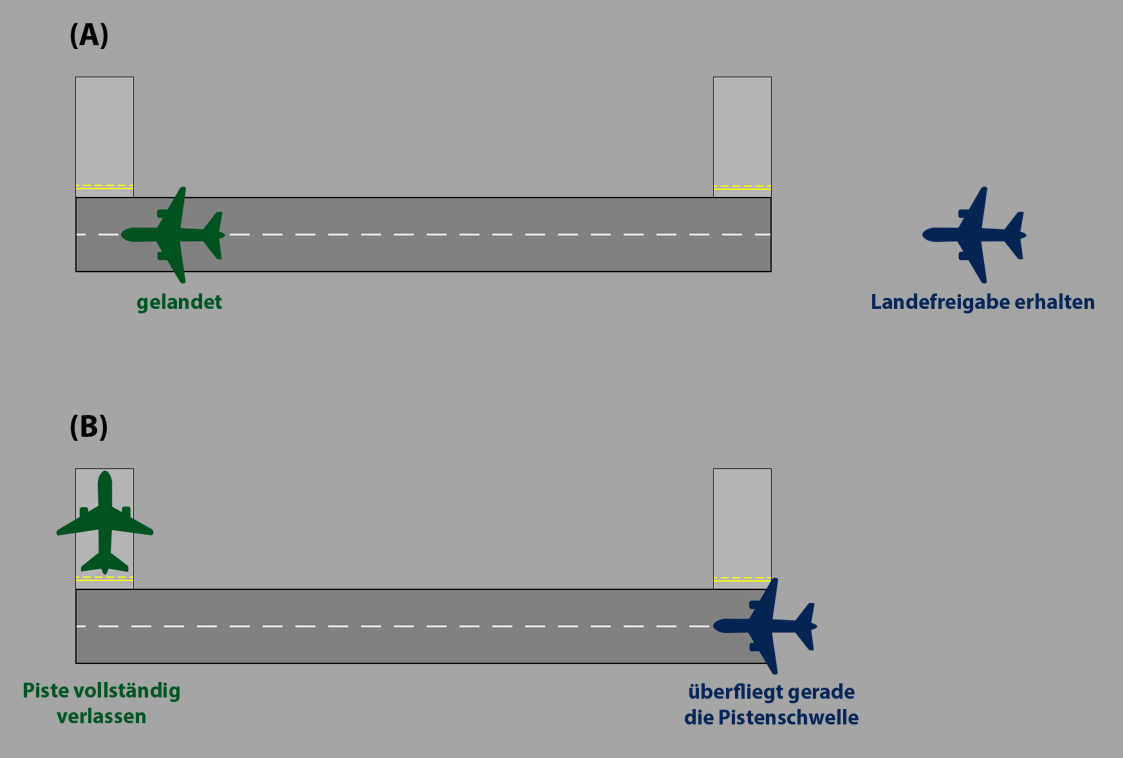Not withholding a takeoff or landing clearance
This procedure is not a mandatory part of S1 training.
Introduction
Under certain circumstances, a take-off or landing clearance can be issued even if the runway is not clear yet. However, there must be reasonable assurance that the runway will be clear as soon as the inbound aircraft crosses the runway threshold or the outbound aircraft begins its take-off run.
This procedure can reduce the frequency load and increase efficiency on the frequency, especially when traffic volumes are high. However, applying it appropriately requires a high level of knowledge and experience.
The crux of the matter is the requirement of "reasonable assurance" for a clear runway as soon as the take-off or landing clearance takes effect. Of course the term "reasonable assurance" allows for a wide variety for interpretation. Because flight safety is nevertheless the top priority in all procedures, it is advisable to delete the word "reasonable" from your own mindset if possible and only apply the procedure if there is "assurance" that the relevant conditions will be met at the necessary time.
Takeoff clearance
Situation (A): Without the procedure described in this article, I may not issue a take-off clearance at this time, as GREEN has not yet crossed the runway end and the runway is therefore still occupied. But considering "reasonable assurance", a controller can issue the take-off clearance at the time of situation A if they have "reasonable assurance" that GREEN will have already flown over the end of the runway and the runway will be clear when BLUE begins the take-off run. This situation is illustrated in situation (B).
This procedure can also be used under reduced runway separation (RRS). Wake turbulence and/or radar separation must still be ensured if necessary.
Landing clearance
Situation (A): Without the procedure described in this article, a landing clearance would not be possible as the runway is still blocked by the landing aircraft GREEN. As controller, however, I can clear the landing by "not holding back a landing clearance" if I have "reasonable assurance" that GREEN will already have left the runway and the runway will therefore be clear when BLUE crosses the runway threshold. In situation (B), the above has occurred and the procedure has been applied correctly. However, for the reasons mentioned under "Take-off clearance", it is difficult to predict the speed when an aircraft leaves the runway and thus to achieve "reasonable assurance".
The procedure can also be used if a departure takes place before the landing traffic. Once this has taken off, it is relatively easy to predict with "reasonable assurance" whether the runway will be clear when the approach crosses the runway threshold. In this case, the landing clearance may be given before the departure has flown over the runway end, provided that the runway will be clear when the approach flies over the runway threshold.
This procedure can also be used under reduced runway separation (RRS). Wake turbulence and/or radar separation must still be ensured if necessary.
Phraseology
The phraseology does not change compared to the "normal" take-off and landing clearances. Traffic information is not mandatory when using this procedure. However, as always, traffic information can contribute to better situational awareness on the part of pilots and controllers.
Examples
The main purpose of this procedure is to use the frequency more efficiently, especially when there is a lot of traffic, by for example avoiding a second unnecessary radio call.
Example 1 (see picture): DLH9AX is at the holding point and reports ready. The previous departure is airborne and will have flown over the end of the runway in approx. 10 seconds. Thanks to this procedure, I can give the takeoff clearance directly, even though there is no runway separation at this point. I have reasonable assurance that the runway separation will exist at the time when the following aircraft begins its takeoff run, as certainly there will be more than 10 seconds between the lineup instruction and the start of the takeoff run.
Example 2 (see picture): TAM8070 reports on 8 NM final approach. The previous inbound has landed and is slowing down on the runway. Thanks to this procedure, I can give the inbound caller their landing clearance directly with the initial call, even though there is no runway separation at that time. I have reasonable assurance that the runway separation will exist at the time when the following inbound flies over the runway threshold, as it still needs approx. 3 minutes to reach the runway and the leading inbound is about to leave the runway.
Of course, as the controller I still have to monitor the situation and if for any reason the separation is not given, I have to withdraw the clearance.
The procedure should not be used in close situations (e.g. if the following inbound is already on short final and the leading inbound has not yet completely left the runway). In this case there is no reasonable assurance about the separation at the time of the threshold overflight. Instead, you should delay the landing clearance until the runway has actually been cleared.




